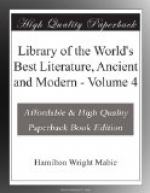The fact that during the long survival of Michael no more of the Banim stories appeared, is sometimes called in as evidence that the latter had little to do with the writing of the series. Michael and John, it was well known, had worked lovingly together, and Michael claimed a part in thirteen of the tales, without excluding his brother from joint authorship. Exactly what each wrote of the joint productions has never been known. A single dramatic work of the Banim brothers has attained to a position in the standard drama, the play of ‘Damon and Pythias,’ a free adaptation from an Italian original, written by John Banim at the instance of Richard Lalor Shiel. The songs are also attributed to John. It is but just to say that the great emigration to the United States which absorbed the Irish during the ’40’s and ’50’s depreciated the sale of such works as those of the Banims to the lowest point, and Michael had good reason, aside from the loss of his brother’s aid, to lay down his pen. The audience of the Irish story-teller had gone away across the great western sea. There was nothing to do but sit by the lonesome hearth and await one’s own to-morrow for the voyage of the greater sea.
THE PUBLICAN’S DREAM
From ‘The Bit o’ Writin’ and Other Tales’
The fair-day had passed over in a little straggling town in the southeast of Ireland, and was succeeded by a languor proportioned to the wild excitement it never failed to create. But of all in the village, its publicans suffered most under the reaction of great bustle. Few of their houses appeared open at broad noon; and some—the envy of their competitors—continued closed even after that late hour. Of these latter, many were of the very humblest kind; little cabins, in fact, skirting the outlets of the village, or standing alone on the roadside a good distance beyond it.
About two o’clock upon the day in question, a house of “Entertainment for Man and Horse,” the very last of the description noticed to be found between the village and the wild tract of mountain country adjacent to it, was opened by the proprietress, who had that moment arisen from bed.
The cabin consisted of only two apartments, and scarce more than nominally even of two; for the half-plastered wicker and straw partition, which professed to cut off a sleeping-nook from the whole area inclosed by the clay walls, was little higher than a tall man, and moreover chinky and porous in many places. Let the assumed distinction be here allowed to stand, however, while the reader casts his eyes around what was sometimes called the kitchen, sometimes the tap-room, sometimes the “dancing-flure.” Forms which had run by the walls, and planks by way of tables which had been propped before them, were turned topsy-turvy, and in some instances broken. Pewter pots and pints, battered and bruised, or squeezed together and flattened, and fragments of twisted glass tumblers,




